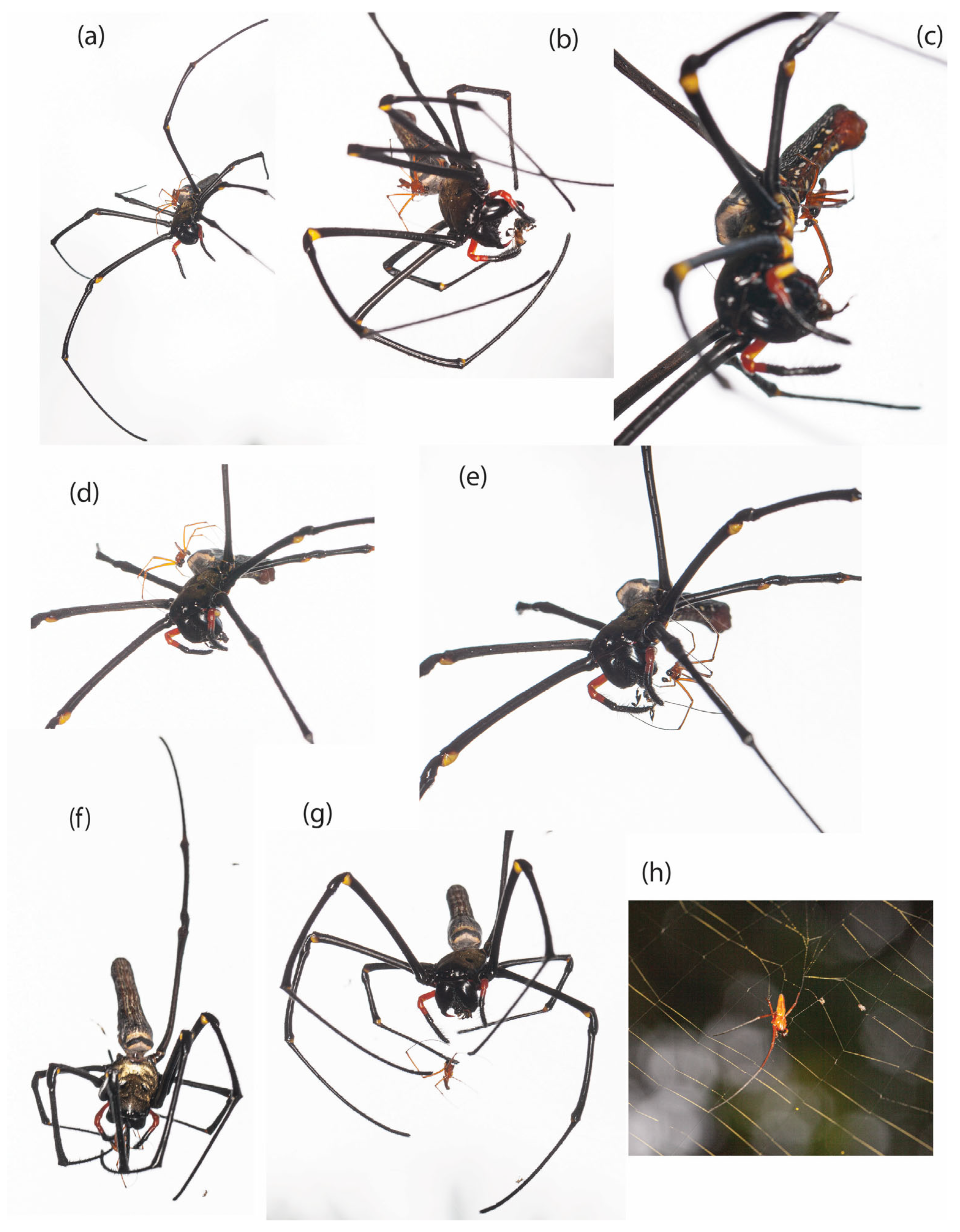To Mate or to Steal Food? A Male Spider’s Dilemma
Abstract
1. Introduction
2. Materials and Methods
3. Results
4. Discussion
5. Conclusions
Author Contributions
Funding
Institutional Review Board Statement
Data Availability Statement
Acknowledgments
Conflicts of Interest
Abbreviations
| eSSD | Extreme female-biased sexual size dimorphism |
References
- Kuntner, M.; Coddington, J.A. Sexual size dimorphism: Evolution and perils of extreme phenotypes in spiders. Annu. Rev. Entomol. 2020, 65, 57–80. [Google Scholar] [CrossRef] [PubMed]
- Blanckenhorn, W.U. Behavioral causes and consequences of sexual size dimorphism. Ethology 2005, 111, 977–1016. [Google Scholar] [CrossRef]
- Kuntner, M.; Hamilton, C.A.; Cheng, R.C.; Gregorič, M.; Lupše, N.; Lokovšek, T.; Lemmon, E.M.; Lemmon, A.R.; Agnarsson, I.; Coddington, J.A.; et al. Golden orbweavers ignore biological rules: Phylogenomic and comparative analyses unravel a complex evolution of sexual size dimorphism. Syst. Biol. 2019, 68, 555–572. [Google Scholar] [CrossRef] [PubMed]
- Rittschof, C.C. Male density affects large-male advantage in the golden silk spider, Nephila clavipes. Behav. Ecol. 2010, 21, 979–985. [Google Scholar] [CrossRef]
- Elgar, M.A.; Schneider, J.M. Evolutionary significance of sexual cannibalism. Adv. Study Behav. 2004, 34, 135–163. [Google Scholar] [CrossRef]
- Kuntner, M.; Gregorič, M.; Zhang, S.; Kralj-Fišer, S.; Li, D. Mating plugs in polyandrous giants: Which sex produces them, when, how and why? PLoS ONE 2012, 7, e40939. [Google Scholar] [CrossRef]
- Elgar, M.A.; Fahey, B.F. Sexual cannibalism, competition, and size dimorphism in the orb-weaving spider Nephila plumipes Latreille (Araneae: Araneoidea). Behav. Ecol. 1996, 7, 195–198. [Google Scholar] [CrossRef]
- Kasumovic, M.M.; Bruce, M.J.; Herberstein, M.E.; Andrade, M.C.B. Risky mate search and mate preference in the golden orb-web spider (Nephila plumipes). Behav. Ecol. 2007, 18, 189–195. [Google Scholar] [CrossRef]
- Kuntner, M.; Kralj-Fišer, S.; Schneider, J.M.; Li, D. Mate plugging via genital mutilation in nephilid spiders: An evolutionary hypothesis. J. Zool. 2009, 277, 257–266. [Google Scholar] [CrossRef]
- Zhang, S.; Kuntner, M.; Li, D. Mate binding: Male adaptation to sexual conflict in the golden orb-web spider (Nephilidae: Nephila pilipes). Anim. Behav. 2011, 82, 1299–1304. [Google Scholar] [CrossRef]
- Harvey, M.S.; Austin, A.D.; Adams, M. The systematics and biology of the spider genus Nephila (Araneae: Nephilidae) in the Australasian region. Invertebr. Syst. 2007, 21, 407–451. [Google Scholar] [CrossRef]
- Fromhage, L.; Schneider, J.M. Safer sex with feeding females: Sexual conflict in a cannibalistic spider. Behav. Ecol. 2005, 16, 377–382. [Google Scholar] [CrossRef]
- Cheng, R.C.; Zhang, S.; Chen, Y.C.; Lee, C.Y.; Chou, Y.L.; Ye, H.Y.; Piorkowski, D.; Liao, C.P.; Tso, I.M. Nutrient intake determines post-maturity molting in the golden orb-web spider Nephila pilipes (Araneae: Araneidae). J. Exp. Biol. 2017, 220, 2260–2264. [Google Scholar] [CrossRef] [PubMed]
- Eberhard, W.G. Why study spider sex: Special traits of spiders facilitate studies of sperm competition and cryptic female choice. J. Arachnol. 2004, 32, 545–556. [Google Scholar] [CrossRef]
- Pruitt, J.N.; Riechert, S.E. Nonconceptive sexual experience diminishes individuals’ latency to mate and increases maternal investment. Anim. Behav. 2011, 81, 789–794. [Google Scholar] [CrossRef]
- Gregorič, M.; Šuen, K.; Cheng, R.C.; Kralj-Fišer, S.; Kuntner, M. Spider behaviors include oral sexual encounters. Sci. Rep. 2016, 6, 25128. [Google Scholar] [CrossRef]
- Sentenská, L.; Pekár, S.; Uhl, G. Deposition, removal and production site of the amorphous mating plug in the spider Philodromus cespitum. Sci. Nat. 2018, 105, 50. [Google Scholar] [CrossRef]
- Méndez, V.; Eberhard, W.G. Removal of genital plugs and insemination by males with normal and experimentally modified palps in Leucauge mariana (Araneae: Tetragnathidae). J. Arachnol. 2014, 42, 284–292. [Google Scholar] [CrossRef]
- Uhl, G.; Nessler, S.H.; Schneider, J.M. Securing paternity in spiders? A review on occurrence and effects of mating plugs and male genital mutilation. Genetica 2010, 138, 75–104. [Google Scholar] [CrossRef]
- Wilder, S.M.; Rypstra, A.L. Males make poor meals: A comparison of nutrient extraction during sexual cannibalism and predation. Oecologia 2010, 162, 617–625. [Google Scholar] [CrossRef]
- Schwartz, S.K.; Wagner, W.E.; Hebets, E.A. Males can benefit from sexual cannibalism facilitated by self-sacrifice. Curr. Biol. 2016, 26, 2794–2799. [Google Scholar] [CrossRef] [PubMed]
- Elgar, M.A. Sexual cannibalism, size dimorphism, and courtship in orb-weaving spiders (Araneidae). Evolution 1991, 45, 444–448. [Google Scholar] [CrossRef] [PubMed]
- Andrade, M.C.B. Female hunger can explain variation in cannibalistic behavior despite male sacrifice in redback spiders. Behav. Ecol. 1998, 9, 33–42. [Google Scholar] [CrossRef]
- Schneider, J.M.; Gilberg, S.; Fromhage, L.; Uhl, G. Sexual conflict over copulation duration in a cannibalistic spider. Anim. Behav. 2006, 71, 781–788. [Google Scholar] [CrossRef]
- Zhang, S.; Yu, L.; Tan, M.; Tan, N.Y.L.; Wong, X.X.B.; Kuntner, M.; Li, D. Male mating strategies to counter sexual conflict in spiders. Commun. Biol. 2022, 5, 534. [Google Scholar] [CrossRef]

Disclaimer/Publisher’s Note: The statements, opinions and data contained in all publications are solely those of the individual author(s) and contributor(s) and not of MDPI and/or the editor(s). MDPI and/or the editor(s) disclaim responsibility for any injury to people or property resulting from any ideas, methods, instructions or products referred to in the content. |
© 2025 by the authors. Licensee MDPI, Basel, Switzerland. This article is an open access article distributed under the terms and conditions of the Creative Commons Attribution (CC BY) license (https://creativecommons.org/licenses/by/4.0/).
Share and Cite
Kuntner, M.; Xu, X.; Li, D. To Mate or to Steal Food? A Male Spider’s Dilemma. Diversity 2025, 17, 281. https://doi.org/10.3390/d17040281
Kuntner M, Xu X, Li D. To Mate or to Steal Food? A Male Spider’s Dilemma. Diversity. 2025; 17(4):281. https://doi.org/10.3390/d17040281
Chicago/Turabian StyleKuntner, Matjaž, Xin Xu, and Daiqin Li. 2025. "To Mate or to Steal Food? A Male Spider’s Dilemma" Diversity 17, no. 4: 281. https://doi.org/10.3390/d17040281
APA StyleKuntner, M., Xu, X., & Li, D. (2025). To Mate or to Steal Food? A Male Spider’s Dilemma. Diversity, 17(4), 281. https://doi.org/10.3390/d17040281







